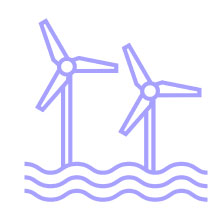Capstone believes that compliance with firming requirements will eventually be more manageable for the renewable energy industry after the Public Utility Commission of Texas (PUCT) amends its original proposal and makes battery storage an eligible resource. ERCOT is considering a new voluntary Energy Attribute Certificate (EAC) program, which would create value streams for low-carbon power producers who could sell them.
- Capstone expects the PUCT to revise its original proposal for firming requirements that would allow battery storage to be an eligible resource. That would spare the Texas renewable energy industry from a worst-case scenario in new firming rules and be a positive for clean energy companies such as Clearway Energy Inc. (CWEN) and Tesla Inc. (TSLA). We believe the penalty for noncompliance will be based on a fixed amount, such as $1,000/MWh, rather than on the value of lost load (VOLL), as PUCT currently proposes.
- Capstone believes that ERCOT proposal NPRR1264 is likely to evolve into a voluntary trading program administered by a third-party vendor. We believe the EACs, an expanded version of the existing voluntary program for RECs (renewable energy certificates), would benefit Texas power producers, particularly in the renewables and low-carbon sectors, by enabling them to sell the certificates. The regulator is still in the early stages of developing protocol language and finalizing the program.
- Capstone believes that the Texas Energy Fund’s Outside ERCOT Grant Program (OEGP) will benefit utilities in addition to Entergy Corp. (ETR), which has already been awarded almost $200 million in grants. Projects must enhance infrastructure modernization, weatherization, reliability and resiliency, or vegetation management. Since the application period opened in May, the program has been oversubscribed, receiving more than a dozen submissions representing nearly 50 projects and totaling over $1.5 billion in funding requests.
Firming Requirements
In 2023, the Texas legislature passed HB1500, which introduced firming requirements for power generators, specifically those that sign an interconnection agreement after January 1, 2027, and have been operating for at least a year. The bill requires those power generators to operate at or above their average generation capability to ensure reliability during high-risk events. Generators that are unable to meet these performance standards—often renewables—must secure dispatchable capacity either by establishing bilateral agreements with energy storage providers or thermal gas plants, or by building their own on-site. These requirements were prevented from taking retroactive effect after SB715, which proposed such action, failed in the House in June.
PUCT released a proposal on July 25th and invited public comment. Stakeholders highlighted multiple items of contention they wanted altered (see Exhibit 1), particularly the performance standard, penalty structure, applicability to battery storage, and the physical response capability trigger.
| Key Topics | PUCT’s Proposal | Stakeholder Reactions |
|---|---|---|
| Seasonal Average Generation Capability (SAGC) | The proposed methodology calculates a single average percentage for each hour in an operating day for each season. | Stakeholders argue that this method misrepresents solar output and penalizes thermal generators due to temperature-driven variations, and that it should instead be technology-neutral and based on expected performance, with values set years in advance to optimize planning. |
| Restricting Batteries from Providing Firming | The proposal makes it difficult for any capacity batteries to be considered firming since only output above SAGC is counted; however, batteries’ output typically equals their seasonal average. | Stakeholders collectively oppose the proposal’s exclusion of battery storage as an eligible firming provider, given that batteries’ flexibility effectively supports grid reliability and firm resources amid significant load growth. |
| Financial Penalties for Failing to Meet Firming Reliability Requirements | Under the proposal, generators that fail to meet the firming reliability requirements will face a financial penalty equal to 20% of the effective value of lost load (VOLL), capped to the 15 most critical hours per season. | Stakeholders advocate for a fixed-price penalty, in particular $1000/MWh, rather than a penalty tied to VOLL, to ensure the long-term certainty needed for long-lead-time investments in future generation resources. |
| Low Operation Reserve Hour (PRC Trigger) | The proposal defines a “low operation reserve hour” or PRC trigger as any period during which the physical response capability (PRC) drops by 3,000 MW for at least 15 minutes. | Some stakeholders argue that the threshold should be 30 minutes to align with ERCOT Watch criteria and that the low operation reserve hour should not be tied to a deployment or shortage in the ERCOT Contingency Reserve Service. |
Impact Across Resources
During the comment period, stakeholders across the generation spectrum discussed how various provisions would affect their resource types. Intermittent generation sources, such as wind and solar, would be hurt by needing to contract with gas plants or build their own on-site. Renewable energy developers, including Clearway Energy, would face higher capital expenditures to secure firmin
Renewable developers also argued that the proposal penalizes technologies that can’t control when they generate, since the proposed high-risk hour and SAGC formulas require them to firm even during non-producing periods, such as overnight. The ERCOT Independent Market Monitor (IMM) argued that the proposed requirements will not meaningfully improve reliability, since scarcity pricing is already a motivating factor, and will instead act as a wealth transfer from non-firm resources, like renewables, to firm dispatchable resources.
Based on our analysis, we expect the physical responsive capability (PRC) threshold to be set at 3,000 MW. There appears to be consensus on this figure, with the exception of the Texas Public Policy Foundation, which recommends a threshold of 6,000 MW.
We expect battery storage to be listed as an eligible resource for firming, which would be a positive for renewable energy companies like Clearway Energy and Tesla. We expect the penalty to be limited to 15 hours per season and based on a fixed amount, such as $1,000/MWh, rather than on VOLL, which the latest proposal recommends. If the penalty for noncompliance is capped at $1,000/MWh, a 300MW generation resource that does not perform in a season would face a maximum penalty of $1,000/MWh * 15 hours * 300MW = $4.5 million. For larger clean energy companies, this may mean that firming requirements may not be punitive as expected. For example, $4.5 million is less than 1% of Clearway Energy’s EBITDA over the 12 months that ended in June.
Thermal generators, particularly independent power producers such as Vistra Corp. (VST) and NRG Energy Inc. (NRG), are cushioned from the impact of firming requirements, since thermals are inherently dispatchable and more likely to meet seasonal reliability thresholds without additional investment. As firming requirements may increase demand for dispatchable capacity, thermal generators will likely face tailwinds.
Next Steps
Capstone believes that PUCT is targeting the December 12th Open Meeting to vote on the final rulemaking for firming requirements. If PUCT staff cannot reach consensus on the rule provisions, we would expect the vote to be pushed to 2026.
Texas’ Energy Attribute Certificates Program
Following the passage of House Bill 1500, the market for renewable energy credits (RECs) in Texas will be voluntary after the expiration of the Solar Renewable Portfolio Standard (SRPS). As a result, the Texas Energy Buyers Alliance has initiated a nodal protocol revision request (NPRR 1264) to create a broader energy attribute certification (EAC) program, where RECs would be considered a subcategory of EACs. An EAC is a tradable instrument that represents all of the attributes associated with one MWh of production from a generator that registers to participate in the program and may be fractional. As currently proposed, it would allow all generators to participate. The rulemaking is still in the early stages and has a long way to go before approval.
ERCOT would function as a data provider to a third-party EAC vendor. We expect that ERCOT will release a request for qualification by the end of the year to determine the feasibility, estimated costs, and required protocol language for the EAC administrator. The registry and trading platform must be able to track attributes, including hour, location, and fuel type, in Watt-hour granularity. According to ERCOT, the independent third party will be chosen with feedback from ERCOT market participants. We believe that a new EAC program could benefit power producers in Texas by enabling them to issue and sell associated EACs, especially those in the renewable and low-carbon sectors.
Texas Energy Fund
In 2023, SB2627 established the Texas Energy Fund (TEF) to help bring additional dispatchable generation online in the state. The TEF allocates $10 billion across four distinct funding programs that aim to either incentivize new natural gas power and support transmission and distribution, or back-up power infrastructure.
- The In-ERCOT Generation Loan Program provides low-interest loans for the construction or expansion of new or existing generation projects that add at least 100 MW of generation capacity to the ERCOT grid.
- The Completion Bonus Grant Program funds new dispatchable generation facilities of 100+ MW completed within the ERCOT region before June 2029. The program pays $120,000 per MW if interconnected before June 1, 2026, and $80,000 per MW if interconnected before June 1, 2029. The fund allocates $7.2 billion to the In-ERCOT generation loan and grant programs.
- The Outside ERCOT Grant Program offers funding to support transmission and distribution infrastructure, or electric generating facilities that are geographically located in Texas but sit outside of the ERCOT region. Eligible projects must fall under one of the following four categories: facility modernization, facility weatherization, reliability and resilience, or vegetation management. This program has been allocated $1 billion of the TEF’s total funding.
- The Texas Backup Power Package Program, which was allocated $1.8 billion in funding, will finance backup power packages at facilities deemed necessary to support the health, safety, and well-being of the community.
In-ERCOT Generation Loan Program
The largest of the funding programs, the In-ERCOT Generation Loan Program, has already executed four loan agreements totaling $1.16 billion in loans and 1,800 MW. The first project to receive a loan, in June 2025, was the Kerrville Public Utility Board’s 122 MW natural gas power plant, the Rock Island Generation Project, which received a $105 million loan. In August, NRG Energy received a $216 million loan for a 456 MW addition to its existing TH Wharton power plant. In September, NRG also received a $562 million loan for a new 721 MW gas unit at the Cedar Bayou Generation Station, the largest project to receive a loan from the program thus far. Most recently, on October 14th, Calpine Corp. was awarded a $278.3 million loan for the Pin Oak Creek Energy Center, a 460 MW natural gas power plant.
There are still 13 applications currently in the program’s due-diligence review process, collectively representing 7,211 MW of proposed dispatchable generation. All projects have submitted Full Interconnection Study (FIS) applications to ERCOT and are progressing through the interconnection process. However, when the In-ERCOT program was first initiated, PUCT claimed it could support up to 10 GW of capacity. The number of applications in the due diligence stage has fluctuated due to projects withdrawing from the process, pointing to project delays from supply chain challenges creating uncertainty around costs and preventing them from meeting program deadlines (see Exhibit 2).
If a project is facing timing constraints and is unable to meet deadlines to receive the loan, they risk investing significant capital and not receiving the financial support they planned for. While the program has a funding disbursement deadline of December 31, 2025, SB 2268, which was passed in the 2025 legislative session, allows PUCT to extend the disbursement deadline on a project-by-project basis if the market factors necessitate it.
Most recently, active participants MPH Bastrop Peakers LLC, NRG Energy Greens Bayou 6, Invenergy, and EMPower USA LLC requested extensions of the initial disbursement deadline for their projects. In their respective requests, MPH Bastrop Peakers and Invenergy cited market factors beyond their control that are impacting their project timelines and ability to meet current deadlines. NRG said that its third project in the queue, Greens Bayou 6, is expected to meet statutory deadlines, but would like to make the request out of caution due to unforeseen circumstances. EmPower USA requested an extension to April 30, 2026, due to supply chain challenges and longer lead times from EPC contractors. If needed, applicants must file extension requests with PUCT staff by November 7, 2025.
While the approval of the first four In-ERCOT loans is a positive sign for independent power producers awaiting loan agreements, such as Vistra, which still has two projects in the application queue, supply chain challenges and forward power prices in Texas create obstacles for the buildout of greenfield natural gas plants.
| Sponsor | Status |
|---|---|
| Kerrville Public Utility Board Facility Corporation; Kerrville Public Utility Board | Granted |
| NRG Energy | Granted |
| NRG Energy: Cedar Bayou 5 | Granted |
| Calpine Corp. | Granted |
| NRG Greens Bayou 6 | Active |
| Competitive Power Ventures (CPV Group LP), GE Vernova | Active |
| Rayburn County Electric Cooperative Inc., Rayburn Energy Station LLC | Active |
| Hull Street Energy through wholly owned subsidiary MPH Bastrop Peakers LLC | Active |
| Mercuria Investments US Inc.; Reliability Design & Development | Active |
| Vistra | Active |
| Vistra | Active |
| EmPower USA LLC; Emerging America Financiera, SAPI de CV; Integrated Gas Services de Mexico; S de RL de CV | Active |
| NightPeak Energy LLC | Active |
| NightPeak Energy LLC | Active |
| Invenergy | Active |
| Invenergy | Active |
| Rockland Capital Partners IV LP | Active |
| Howard Power Generation LLC | Withdrawn |
| Hunt Energy Network LLC; John Hancock Life Insurance Co. (USA); Manulife Infrastructure Fund III AIV Holdings B, LP | Withdrawn |
| LS Power Equity Advisors LLC | Withdrawn |
| Constellation Energy Generation LLC | Withdrawn |
| Wattbridge Energy IPP Holdings | Withdrawn |
| Wattbridge Energy IPP Holdings | Withdrawn |
| Engie Flexible Generation NA LLC | Withdrawn |
| Frontier Group of Cos. (Lonestar Industrial Park LLC) | Denied |
| EmberClear Management, Jupiter Island Capital | Denied |
| NextEra and Aegle Power | Denied |
Outside-ERCOT Grant Program
Of the $1 billion Texas lawmakers have allocated to the Texas Energy Fund Outside-ERCOT Program (OEGP), about $627 million has been disbursed across 10 projects thus far (see Exhibit 3). Notable awardees include Entergy, which received almost $200 million across two projects, reaching the per-applicant program cap.
Since applications opened in May, the program has received over a dozen submissions representing almost 50 projects totaling more than $1.5 billion. We believe the influx of applications and progress in disbursing funding highlight the demand for generators outside ERCOT’s region in Texas. We foresee the program reaching its $1 billion cap.
| Applicant | Grant Award Amount |
|---|---|
| Southwestern Electric Power Company | $200 million |
| El Paso Electric | $17.7 million |
| El Paso Electric | $43.4 million |
| North Plains Electric Cooperative Inc. | $1.8 million |
| North Plains Electric Cooperative Inc. | $20.4 million |
| Entergy | $197.2 million |
| Entergy | $2.4 million |
| Sam Houston Electric Cooperative | $87 million |
| East Texas Electric Cooperative | $21.2 million |
| East Texas Electric Cooperative | $30.1 million |
Upcoming Catalysts
- November 7, 2025: Deadline for Texas Energy Fund In-ERCOT Generation Loan Program applicants to submit a request for an extension to the statutory loan disbursement deadline.
- November / December 2025: ERCOT to release a request for qualification for a third-party registry and trading platform to administer a new voluntary EAC program.
- December 12, 2025: Target date for PUCT to vote on final rulemaking for firming requirements.
- December 31, 2025: Texas Energy Fund loan disbursement deadline without extension.
- June 1, 2026: Operation date deadline to receive $120,000/MW Texas Energy Fund completion grant.
- June 1, 2029: Operation date deadline to receive $80,000/MW Texas Energy Fund completion grant.
In Case You Missed It: A roundup of Capstone’s recent notes on ERCOT
- RTO/ISO Monthly Update: Texas, SPP, and PJM Examine Balancing Large Loads and Consumers; FERC Appointees Positive for Thermal Generation, September 22, 2025
- Data Center Biweekly: PJM Advances Data Center Proposal; Pennsylvania Aims to Finalize Utility Tariff by Year End; Tax Treatments Show Resiliency, September 19, 2025
- In Case You Missed It | Weekly Energy & Sustainability Takeaways: Section 232 Wind Turbine Investigation, DOE Retains Coal Plant, and More, August 23, 2025
- Data Center Biweekly: PJM and Southwest Power Pool Grid Flexibility Conditions Set to Trigger Jurisdictional Tensions; Local Opposition Persists, August 21, 2025
- RTO/ISO Monthly: PJM, Southwest Power Pool Weigh Data Center Fast-Track Tradeoffs; Headwinds for MISO Transmission, Texas Renewables, August 20, 2025
- ERCOT Roundup: PUCT Releases Rulemaking Timelines for SB 6; Firming Requirements to Benefit Dispatchable Resources; TEF Loan Finalized, August 12, 2025
- In Case You Missed It | Weekly Energy & Sustainability Takeaways: Wind Energy Area Withdrawals, California LCFS Proposed Revision, and More, August 2, 2025
- ERCOT Quick Take: Protocol Revision Hinders Battery Storage Non-Spin Eligibility; Presents Tailwinds for Thermal Generators like Vistra and NRG, August 1, 2025
- Data Center Biweekly: PA Attracts Investments; Misalignment Between Lawmakers, Regulators May Drive Industry to ‘Bring Your Own Power’ Model, July 24, 2025
- RTO/ISO Monthly: FERC Nominee Positive for Thermal Power; New ERCOT Rules Pose Risk for Storage; High Prices Expected in PJM Auction, July 18, 2025





























